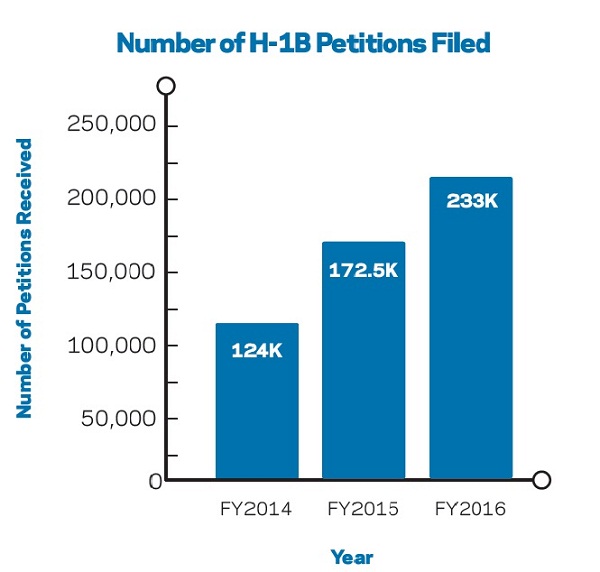As of this writing, the H-1B filing season for fiscal year 2016 had just concluded, though if you blinked you might have missed it. That’s because, for the third consecutive year, the window was open for the minimum required span of just five business days. And if your firm did file H-1B petitions with US Customs and Immigration Services (USCIS), the statistics indicate that a majority were probably unsuccessful.
The H-1B visa program allows foreign citizens who possess highly specialized knowledge or training, such as in science or technology, to legally work in the US. Individuals granted H-1B visas are authorized to remain in the US for a period of up to three years, after which they may apply for an extension, though generally not to encompass more than six years in total. Visas granted in the April filing season convey the right to begin working on October 1 of that year, when the Federal government’s new fiscal year commences.
There is a limit, or cap, of 65,000 on the number of H-1B visas that may be issued in a given year, with an additional 20,000 reserved for individuals who have earned a US master’s degree or above. The H-1B petition filing period is mandated by law to remain open at least five business days, or until the cap is reached, whichever is longer. If USCIS receives more petitions than can be granted under the cap, it will commence a computerized random selection process, or lottery. The lottery is first conducted for petitions claiming the advanced degree exemption, with any petitions not selected in that round (those in excess of the 20,000 advanced degree cap) then added to the regular H-1B petitions for a second lottery to allocate the 65,000.
As shown in the accompanying graph, the volume of H-1B petitions received by USCIS has exceeded the cap within the first week of the filing period for each of the last three fiscal years, previous to which this had not occurred since the FY2008 filing period. Moreover, the number of petitions received this year increased by about 35% from fiscal-year 2015, which in turn were up 39% from the prior year. One factor driving the increase is that, for many applicants, this represents the only viable path to work legally in the US, so if their petition is unsuccessful they must try again next year. Meanwhile, employers anticipating a lottery tend to increase the number of petitions they file due to the likelihood that only a fraction of those will be granted.
In the supply-constrained market for skilled IT workers, the H-1B program has represented a critical source of talent. Thus, the hi-tech industry has become increasingly vocal in its calls for lawmakers to raise the cap, or to do away with the restrictive program in favor of liberalizing other avenues for employment-based immigration. It seems Congress has been listening, as the Senate introduced in January the Immigration Innovation (or “I-Squared”) Act of 2015. Among many reforms, the proposed legislation would increase the base H-1B cap from 65,000 to 115,000 and allow it to float as high as 195,000 for a given fiscal year based on the volume of early filings, while doing away with the cap on advanced degree holders altogether.
Though it might seem dubious to pin one’s hopes on any congressional action in the current political climate, it should be noted that this is one issue with significant bipartisan support, as evidenced by this bill’s co-sponsors: three Democrats and three Republicans. That said, both parties also find vocal critics of the H-1B program among their membership, most focused on the idea that it creates more difficulty for American tech workers in securing jobs or broadly suppresses industry wages.
There is some potential relief in store for the near-term while we wait to learn the fate of the I-Squared Act, as one of its provisions has already been adopted. Historically, husbands or wives of H-1B visa holders, known as H-4 dependent spouses, have not been permitted to work in the US. A final rule published by USCIS in late February will soon change that, allowing H-4 holders to seek employment if married to an H-1B nonimmigrant who has reached certain milestones on the path to obtaining permanent residency. As of this writing, the agency was set to begin accepting applications for employment authorization from H-4 spouses on May 26. The agency anticipates receiving roughly 179,600 in the first year and 55,000 annually thereafter.
The most intractable impediment to passing the I-Squared Act or any similar relief for work visa caps may be the broader fight over comprehensive immigration reform. For example, the AFL-CIO endorsed a larger immigration bill passed by last year’s Senate, which included a similar increase in the allocation of H-1B visas, but has voiced resistance to standalone legislation. One can hardly imagine congressional Democrats rallying behind any bill opposed by the powerful labor union, which represents such a wide swath of the party’s constituency.







